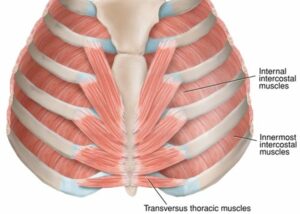 “Anything with wings always comes down in the end”. ~ Simone Weil
“Anything with wings always comes down in the end”. ~ Simone Weil
One of the most important groups of muscles often ignored by massage therapists is the intercostal muscles. These of course give rise to the deliciousness of “spare ribs”. But far more importantly they are core muscles involved more or less in every breath. The reluctance to work the intercostals seems to come from some boundary issues, most unconscious, from working in any detail on the chest. This is so ironic because not only is the area linked vitally with respiratory function, but also with the feelings of love, courage, and inspiration. And the healths of the sides and back of the upper thorax also depend on the tone and freedom of the intercostals and their associated ribs.
There are the external intercostals, which assist in inhalation; deep to these are the internal intercostals, which assist in expiration; and deep to these are the innermost intercostals. Especially the transversus thoracis (a cool muscle which looks like five fingers reaching up on each side of your inner ribs) that also assists in expiration.
Look at and feel between the ribs. Do you feel a relative lack of movement between any two ribs? If so, gently coax more movement into the upper of the two ribs, usually with three fingers of either hand, letting your other hand rest gently along the side of ribcage. Have patience and compassion as the client is given the opportunity to let go of their tension there.
Of course you may want to explain before the session, how more detailed work in the front, back and sides of the chest can provide great benefits – both physical and in terms of stress relief. Explain how you can work here and that the boundaries – with respect to breasts, hairy chests, etc. – will be fully respected. And do give them the opportunity to say no.
If and when you do have this permission, really enjoy giving the intercostals long overdue care that have earned, working on your behalf for so long without calling attention to themselves. The client will feel the buoyancy of their wings, greater excursion for the lungs themselves, and, often, an enhanced sense of tension relief, emotional freedom, encouragement and care that can make a big difference in their lives.
Lastly, speaking to the experience of freed intercostals, let me share a beautiful story from Simone Weil. When I read it, it helps remind me, that efforting in life is not needed so much as letting the heart have its wings.
Simone Weil –
“There are people who try to raise their souls like a man continually taking standing jumps in the hopes that, if he jumps higher every day, a time may come when he will no longer fall back but will go right up to the sky. Thus occupied he cannot look at the sky. We cannot take a single step toward heaven. It is not in our power to travel in a vertical direction. If however we look heavenward for a long time, God comes and takes us up. He raises us easily. As Aeschylus says, “There is no effort in what is divine.” There is an easiness in salvation which is more difficult to us than all our efforts.
In one of Grimm’s stories there is a competition between a giant and a little tailor to see which is the stronger. The giant throws a stone so high that it takes a very long time before it comes down again. The little tailor lets a bird fly and it does not come down at all. Anything without wings always comes down again in the end.”
- For information regarding TLC Upcoming Massage Therapy CE Workshops: Continuing Education List
- For more information on training the intercostals: These Underappreciated Muscles Can Help You Go Farther, Stronger

